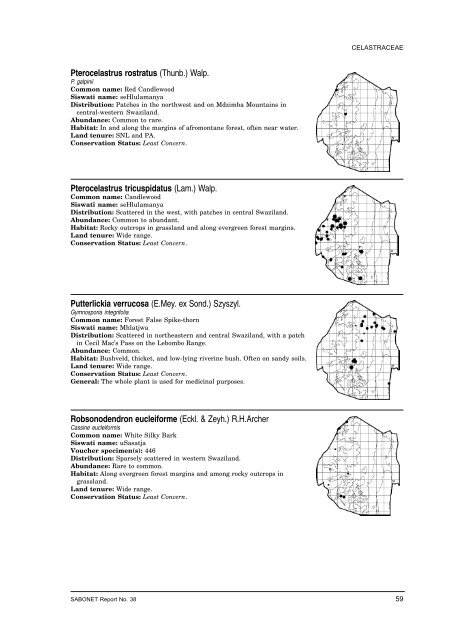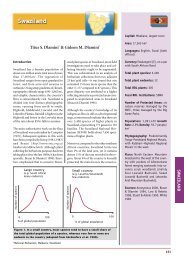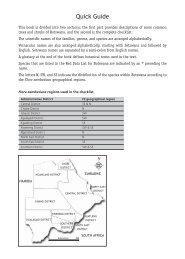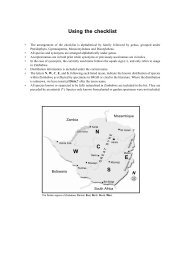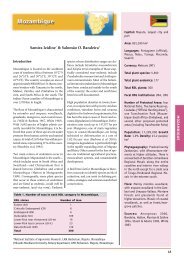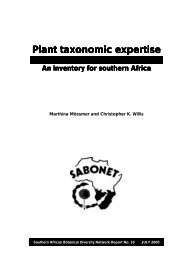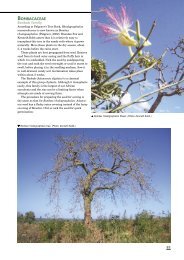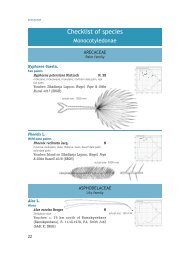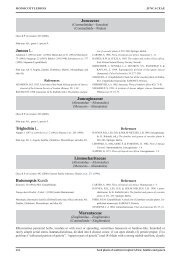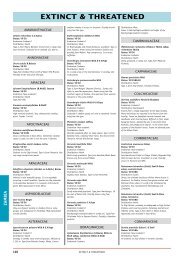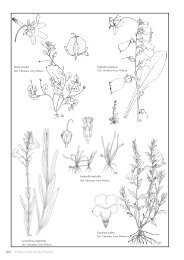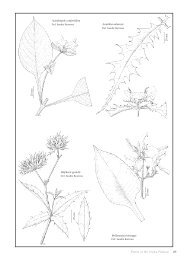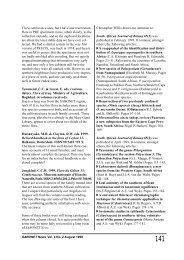Pterocelastrus rostratus (Thunb.) Walp. Pterocelastrus ... - SABONET
Pterocelastrus rostratus (Thunb.) Walp. Pterocelastrus ... - SABONET
Pterocelastrus rostratus (Thunb.) Walp. Pterocelastrus ... - SABONET
You also want an ePaper? Increase the reach of your titles
YUMPU automatically turns print PDFs into web optimized ePapers that Google loves.
<strong>Pterocelastrus</strong> <strong>rostratus</strong> (<strong>Thunb</strong>.) <strong>Walp</strong>.<br />
P. galpinii<br />
Common name: Red Candlewood<br />
Siswati name: seHlulamanya<br />
Distribution: Patches in the northwest and on Mdzimba Mountains in<br />
central-western Swaziland.<br />
Abundance: Common to rare.<br />
Habitat: In and along the margins of afromontane forest, often near water.<br />
Land tenure: SNL and PA.<br />
Conservation Status: Least Concern.<br />
<strong>Pterocelastrus</strong> tricuspidatus (Lam.) <strong>Walp</strong>.<br />
Common name: Candlewood<br />
Siswati name: seHlulamanya<br />
Distribution: Scattered in the west, with patches in central Swaziland.<br />
Abundance: Common to abundant.<br />
Habitat: Rocky outcrops in grassland and along evergreen forest margins.<br />
Land tenure: Wide range.<br />
Conservation Status: Least Concern.<br />
Putterlickia verrucosa (E.Mey. ex Sond.) Szyszyl.<br />
Gymnosporia integrifolia<br />
Common name: Forest False Spike-thorn<br />
Siswati name: Mhlatjwa<br />
Distribution: Scattered in northeastern and central Swaziland, with a patch<br />
in Cecil Mac’s Pass on the Lebombo Range.<br />
Abundance: Common.<br />
Habitat: Bushveld, thicket, and low-lying riverine bush. Often on sandy soils.<br />
Land tenure: Wide range.<br />
Conservation Status: Least Concern.<br />
General: The whole plant is used for medicinal purposes.<br />
Robsonodendron eucleiforme (Eckl. & Zeyh.) R.H.Archer<br />
Cassine eucleiformis<br />
Common name: White Silky Bark<br />
Siswati name: uSasatja<br />
Voucher specimen(s): 446<br />
Distribution: Sparsely scattered in western Swaziland.<br />
Abundance: Rare to common.<br />
Habitat: Along evergreen forest margins and among rocky outcrops in<br />
grassland.<br />
Land tenure: Wide range.<br />
Conservation Status: Least Concern.<br />
CELASTRACEAE<br />
<strong>SABONET</strong> Report No. 38 59
CELASTRACEAE<br />
Salacia leptoclada Tul.<br />
S. baumannii, S. wardii<br />
Common name: Sand Lemon Rope<br />
Voucher specimen(s): 199, 770, 1007<br />
Distribution: Restricted to the Lebombo Range.<br />
Abundance: Common to abundant.<br />
Habitat: Understorey of Lebombo forest.<br />
Land tenure: TDL and SNL.<br />
Conservation Status: Least Concern.<br />
CELTIDACEAE<br />
Celtis africana Burm.f.<br />
C. kraussiana<br />
Common name: White Stinkwood<br />
Siswati name: umVumvu, luHlolo lolukhulu, Mbelangoma<br />
Distribution: Widespread in western and central Swaziland and on the<br />
Lebombo Range.<br />
Abundance: Common.<br />
Habitat: Bushveld, forest, riverine vegetation, and wooded grassland.<br />
Occasionally on rocky outcrops.<br />
Land tenure: Wide range.<br />
Conservation Status: Least Concern.<br />
General: The roots and bark are used medicinally as an aphrodisiac.<br />
Celtis gomphophylla Baker<br />
C. dioica, C. durandii<br />
Common name: Mock White Stinkwood, Rough-leaved White Stinkwood<br />
Siswati name: umVumvu<br />
Voucher specimen(s): 144, 772, 953<br />
Distribution: Restricted to the Lebombo Range.<br />
Abundance: Common to rare.<br />
Habitat: Lebombo forest.<br />
Land tenure: Wide range.<br />
Conservation Status: Endangered.<br />
Celtis mildbraedii Engl.<br />
C. franksiae<br />
Common name: Red-fruit White Stinkwood<br />
Siswati name: uZinhlu, siCalaba<br />
Voucher specimen(s): 139<br />
Distribution: Restricted to Jilobi Forest on the Lebombo Range.<br />
Abundance: Rare.<br />
Habitat: Lebombo forest.<br />
Land tenure: SNL.<br />
Conservation Status: Critically Endangered.<br />
General: In the past this species has been identified in small forest patches<br />
in Mlawula and at Forbes Reef. However, its existence in these areas at<br />
present needs verification and further surveying is required. Its location<br />
in Jilobi Forest is threatened by indiscriminate harvesting activities and<br />
alien weed invasion, especially Chromolaena odorata.<br />
60 <strong>SABONET</strong> Report No. 38
Chaetacme aristata E.Mey. ex Planch.<br />
C. nitida, C. serrata<br />
Common name: Thorny Elm<br />
Siswati name: umBambangwe<br />
Voucher specimen(s): 780<br />
Distribution: Widespread on the Lebombo Range, scattered in centralsouthern<br />
Swaziland, with an isolated patch near Ngwenya North in the<br />
west.<br />
Abundance: Common.<br />
Habitat: Forest, riparian thicket, bushveld and in forested ravines.<br />
Land tenure: Wide range.<br />
Conservation Status: Least Concern.<br />
Trema orientalis (L.) Blume<br />
Common name: Pigeonwood<br />
Siswati name: umBalakancane, Umphahlo, Nsakasaka<br />
Distribution: Widespread throughout most of Swaziland.<br />
Abundance: Common.<br />
Habitat: Near watercourses, along the margins of and in forests, wooded<br />
grassland, disturbed areas, and bushveld. Often a pioneer species.<br />
Land tenure: Wide range.<br />
Conservation Status: Least Concern.<br />
CHRYSOBALANACEAE<br />
Parinari capensis Harv. subsp. capensis<br />
Common name: Sand Apple<br />
Siswati name: umKhuna<br />
Distribution: Fairly widespread in the west, with patches in northern,<br />
central, and southern Swaziland.<br />
Abundance: Abundant.<br />
Habitat: Grows in colonies in high and medium-altitude grassland, wooded<br />
grassland, and bushveld.<br />
Land tenure: Wide range.<br />
Conservation Status: Least Concern.<br />
General: The fruit is eaten locally.<br />
Parinari curatellifolia Planch. ex Benth.<br />
P. mobola<br />
Common name: Mobola Plum<br />
Siswati name: maBulwa, umKhuna<br />
Voucher specimen(s): 309<br />
Distribution: Scattered in northwestern Swaziland, with a disjunct patch at<br />
Mahamba in the southwest.<br />
Abundance: Abundant to common.<br />
Habitat: Moist bushveld and grassland at medium and high altitudes.<br />
Land tenure: SNL and PA.<br />
Conservation Status: Least Concern.<br />
General: The fruit is eaten locally.<br />
CELTIDACEAE<br />
<strong>SABONET</strong> Report No. 38 61
CLUSIACEAE<br />
CLUSIACEAE<br />
Garcinia gerrardii Harv. ex Sim<br />
G. natalensis, G. transvaalensis<br />
Common name: Forest Mangosteen<br />
Siswati name: siKhelamfene<br />
Distribution: Sparsely scattered in western Swaziland.<br />
Abundance: Common.<br />
Habitat: Deep shade in evergreen forest. Often near water.<br />
Land tenure: Wide range.<br />
Conservation Status: Least Concern.<br />
Garcinia livingstonei T.Anderson<br />
Common name: African Mangosteen, Lowveld Mangosteen<br />
Siswati name: siNyula<br />
Distribution: Scattered on the Lebombo Range.<br />
Abundance: Rare to common.<br />
Habitat: Rocky outcrops in Lebombo bushveld and on forest fringes.<br />
Land tenure: Wide range.<br />
Conservation Status: Least Concern.<br />
COMBRETACEAE<br />
Combretum apiculatum Sond. subsp. apiculatum<br />
Common name: Red Bushwillow<br />
Siswati name: imBondvo lemnyama, Imbondvo-lemhlophe<br />
Distribution: Scattered in eastern, central, and northern Swaziland.<br />
Abundance: Common to abundant.<br />
Habitat: Bushveld, woodland, dry thicket, grassland, and on rocky hillsides.<br />
Land tenure: Wide range.<br />
Conservation Status: Least Concern.<br />
General: Termite resistant wood utilised for fuel and fence posts. The roots<br />
and bark are used for treating open wounds.<br />
Combretum collinum Fresen. subsp. suluense (Engl. & Diels) Okafor<br />
Common name: Weeping Bushwillow<br />
Siswati name: imBondvo lemhlophe<br />
Voucher specimen(s): 169<br />
Distribution: Widespread in northern and central Swaziland.<br />
Abundance: Abundant.<br />
Habitat: Open woodland and bushveld at medium altitudes. Often associated<br />
with granite.<br />
Land tenure: Wide range.<br />
Conservation Status: Least Concern.<br />
General: The branches are used for constructing the King’s kraal.<br />
62 <strong>SABONET</strong> Report No. 38
Combretum edwardsii Exell<br />
Common name: Forest Climbing Bushwillow, Natal Bushwillow<br />
Voucher specimen(s): 570<br />
Distribution: Disjunct patches at Bulembu in the northwest and Ngudzeni<br />
in southern-central Swaziland.<br />
Abundance: Common.<br />
Habitat: Canopy of afromontane forest or on rocky hillsides in bushveld.<br />
Land tenure: SNL.<br />
Conservation Status: Least Concern.<br />
Combretum erythrophyllum (Burch.) Sond.<br />
Common name: River Bushwillow<br />
Siswati name: umDvubu, imBondvo-lemhlophe<br />
Voucher specimen(s): 161, 313<br />
Distribution: Scattered in western and central Swaziland and on the<br />
Lebombo Range.<br />
Abundance: Common.<br />
Habitat: Near watercourses and on river banks at medium altitude.<br />
Land tenure: Wide range.<br />
Conservation Status: Least Concern.<br />
General: The roots are used for assisting with foetal abortion.<br />
Combretum hereroense Schinz<br />
C. transvaalense, C. rhodesicum<br />
Common name: Russet Bushwillow<br />
Siswati name: siHlalavane, Umphulumbu, Livimbela, umDvubu<br />
Distribution: Widespread in central and eastern Swaziland.<br />
Abundance: Common to abundant.<br />
Habitat: Bushveld, thicket near drainage lines, and woodland. Often on<br />
termitaria.<br />
Land tenure: Wide range.<br />
Conservation Status: Least Concern.<br />
General: The wood is used for furniture and branches as a thatch support.<br />
Combretum imberbe Wawra<br />
Common name: Leadwood<br />
Siswati name: umMono, iMpondozendhlovu, Umphulumbu, liPhodva<br />
lendlovu<br />
Distribution: Fairly widespread in northeastern and central-eastern<br />
Swaziland.<br />
Abundance: Common to abundant.<br />
Habitat: Acacia nigrescens woodland and bushveld at low altitudes. Often<br />
near watercourses on alluvial soils.<br />
Land tenure: Wide range.<br />
Conservation Status: Least Concern.<br />
General: Very hard wood used in the past for railway sleepers. It is currently<br />
used for fence poles and fuel. The roots are used for fever reduction. This<br />
species has been known to live for hundreds of years and a dated specimen,<br />
although now dead, at Hlane National Park was estimated at being some<br />
1,050 years old (Roques pers. comm.).<br />
COMBRETACEAE<br />
<strong>SABONET</strong> Report No. 38 63
COMBRETACEAE<br />
Combretum kraussii Hochst.<br />
Common name: Forest Bushwillow<br />
Siswati name: imBondvo lemhlophe<br />
Distribution: Widespread in western and south-central Swaziland, with an<br />
isolated patch at Muti-muti Nature Reserve on the Lebombo Range.<br />
Abundance: Abundant.<br />
Habitat: Canopy species in or near evergreen forest, among rocky outcrops<br />
in grassland, and moist bushveld. Often near water.<br />
Land tenure: Wide range.<br />
Conservation Status: Least Concern.<br />
Combretum microphyllum Klotzsch<br />
C. paniculatum subsp. microphyllum<br />
Common name: Flame Climbing Bushwillow<br />
Siswati name: umHlalanyosi<br />
Voucher specimen(s): 133<br />
Distribution: Sparsely scattered in south-central, eastern, and northern<br />
Swaziland.<br />
Abundance: Common.<br />
Habitat: Bushveld, dry woodland, and along river and stream banks at<br />
lower altitude.<br />
Land tenure: Wide range.<br />
Conservation Status: Least Concern.<br />
Combretum moggii Exell<br />
Common name: Rock Bush Willow<br />
Voucher specimen(s): 639<br />
Distribution: Isolated patch near Gege in southwestern Swaziland.<br />
Abundance: Abundant.<br />
Habitat: Among rocks on quartzite ridges in high-altitude grassland.<br />
Land tenure: SNL.<br />
Conservation Status: Least Concern.<br />
General: Currently listed as an endemic to South Africa.<br />
Combretum molle R.Br. ex G.Don<br />
C. velutinum, C. gueinzii<br />
Common name: Velvet Bushwillow<br />
Siswati name: imBondvo lemhlophe, Umhlalavane, imBondvo lemnyama,<br />
inKukutwane<br />
Distribution: Widespread throughout most of Swaziland.<br />
Abundance: Common to abundant.<br />
Habitat: Occurs over a wide range of altitudes in bushveld, woodland,<br />
grassland, and on rocky hillsides.<br />
Land tenure: Wide range.<br />
Conservation Status: Least Concern.<br />
General: Termite resistant wood utilised for various implements and fence<br />
posts. The branches are used for firewood and constructing the King’s kraal.<br />
64 <strong>SABONET</strong> Report No. 38
Combretum woodii Dummer<br />
Common name: Large-leaved Forest Bushwillow<br />
Siswati name: umBhondvo sehlatsi, imBondvo lemhlophe<br />
Voucher specimen(s): 42, 300, 662, 675, 677, 678, 789, 980<br />
Distribution: Widespread on the Lebombo Range, with patches in central<br />
Swaziland and along the Ugutugulo River in northwestern Swaziland.<br />
Abundance: Common.<br />
Habitat: Forest, forested ravines, riverine vegetation and bushveld. Often on<br />
rocky slopes.<br />
Land tenure: Wide range.<br />
Conservation Status: Least Concern.<br />
General: The trunk is used for building cattle yokes.<br />
Combretum zeyheri Sond.<br />
Common name: Large-fruit Bushwillow<br />
Siswati name: imMbondvo-lemhlophe<br />
Voucher specimen(s): 176<br />
Distribution: Scattered in northern, central, and eastern Swaziland.<br />
Abundance: Common.<br />
Habitat: Bushveld, woodland, dry thicket, grassland, and on rocky hillsides.<br />
Land tenure: Wide range.<br />
Conservation Status: Least Concern.<br />
General: The termite resistant wood is utilised for timber and the branches<br />
for constructing the King’s kraal.<br />
Terminalia phanerophlebia Engl. & Diels<br />
Common name: Lebombo Cluster-leaf<br />
Siswati name: maMbonjwane, umaNgwe, umHonono, siHhomuhhomu<br />
Voucher specimen(s): 1028<br />
Distribution: Scattered in central, northern, and eastern Swaziland.<br />
Abundance: Common.<br />
Habitat: Bushveld, thicket, and on rocky hillsides. Often near rivers and<br />
streams.<br />
Land tenure: Wide range.<br />
Conservation Status: Least Concern.<br />
General: The wood is used for firewood and timber and the roots for medicinal<br />
purposes.<br />
Terminalia sericea Burch. ex DC.<br />
Common name: Silver Cluster-leaf<br />
Siswati name: umHonono, eMangwe, Mangwe lamhlophe, si Hhomuhhomu<br />
Distribution: Widespread in northern and central Swaziland.<br />
Abundance: Abundant.<br />
Habitat: Woodland and bushveld, normally associated with sandy soils.<br />
Often a pioneer forming dense stands.<br />
Land tenure: Wide range.<br />
Conservation Status: Least Concern.<br />
General: The bark is used as a poison antidote and the trunk for construction.<br />
COMBRETACEAE<br />
<strong>SABONET</strong> Report No. 38 65
CONNARACEAE<br />
CONNARACEAE<br />
Cnestis polyphylla Lam.<br />
C. natalensis<br />
Common name: Itch-Pod<br />
Siswati name: liHlozi<br />
Distribution: Scattered in northwestern Swaziland.<br />
Abundance: Common.<br />
Habitat: Understorey of evergreen forest and on wooded hillsides.<br />
Land tenure: Wide range.<br />
Conservation Status: Least Concern.<br />
CORNACEAE<br />
Curtisia dentata (Burm. f.) C.A.Sm.<br />
C. faginea<br />
Common name: Assegaai<br />
Siswati name: liNcayi, umSenge, umBoyi<br />
Voucher specimen(s): 531<br />
Distribution: Scattered in western and northwestern Swaziland.<br />
Abundance: Common.<br />
Habitat: Afromontane forest, often along the margins, and on grassy<br />
mountain slopes.<br />
Land tenure: Wide range.<br />
Conservation Status: Should be considered for Near Threatened status.<br />
General: The wood is used for carpentry and the bark to treat stomach<br />
complaints and for blood purification. This species is in high demand by<br />
the traditional medicine markets and it is becoming more difficult to find<br />
large mature specimens in the wild.<br />
EBENACEAE<br />
Diospyros dichrophylla (Gand.) De Winter<br />
Royena dichrophylla<br />
Common name: Poison Star-apple<br />
Siswati name: umChafutane lomnyama<br />
Voucher specimen(s): 474, 508, 785<br />
Distribution: Widespread on the Lebombo Range, with patches in central<br />
and southern Swaziland.<br />
Abundance: Abundant.<br />
Habitat: Bushveld, along forest margins, and in wooded grassland.<br />
Land tenure: Wide range.<br />
Conservation Status: Least Concern.<br />
Diospyros galpinii (Hiern) De Winter<br />
Common name: Dwarf Star-apple, Dwarf Hairy Jackalberry<br />
Siswati name: Siphiphabantwana, iNdodemnyama<br />
Distribution: Scattered in western and central Swaziland, with patches on<br />
the Lebombo Range.<br />
Abundance: Common to abundant.<br />
Habitat: On grassy mountain slopes and in wooded grassland.<br />
Land tenure: Wide range.<br />
Conservation Status: Least Concern.<br />
General: The root is used medicinally.<br />
66 <strong>SABONET</strong> Report No. 38
Diospyros lycioides Desf. subsp. guerkei (Kuntze) De Winter<br />
Royena guerkei<br />
Common name: Quilted Bluebush<br />
Siswati name: umChafutane lomhlophe, Lomnyama<br />
Voucher specimen(s): 718<br />
Distribution: Widespread in the west, with patches in central and eastern<br />
Swaziland.<br />
Abundance: Common to abundant.<br />
Habitat: Grassland, riverine vegetation, rocky outcrops, bushveld, and<br />
thicket.<br />
Land tenure: Wide range.<br />
Conservation Status: Least Concern.<br />
General: The fruit is eaten locally.<br />
Diospyros lycioides Desf. subsp. nitens (Harv. ex Hiern) De Winter<br />
Royena nitens<br />
Common name: Silvery Bluebush<br />
Siswati name: umChafutane, Lomnyama<br />
Voucher specimen(s): 579<br />
Distribution: Isolated patches in the Manzini area in central Swaziland.<br />
Abundance: Common to rare.<br />
Habitat: Grassy hillsides and wooded grassland.<br />
Land tenure: Urban and TDL.<br />
Conservation Status: Least Concern.<br />
Diospyros lycioides Desf. subsp. sericea (Bernh.) De Winter<br />
Royena sericea<br />
Common name: Eastern Bluebush<br />
Siswati name: umChafutane, Lomnyama<br />
Voucher specimen(s): 379, 511, 576<br />
Distribution: Scattered in northern, central, and eastern Swaziland.<br />
Abundance: Common to abundant.<br />
Habitat: Bushveld, grassland, along forest margins, and in wooded grassland.<br />
Land tenure: Wide range.<br />
Conservation Status: Least Concern.<br />
General: The fruit is eaten locally.<br />
Diospyros mespiliformis Hochst. ex A.DC.<br />
Common name: Jackal-berry, African Ebony<br />
Siswati name: umToma<br />
Distribution: Restricted to northern Swaziland.<br />
Abundance: Common to rare.<br />
Habitat: Low-lying riverine vegetation, bushveld, and woodland. Occasionally<br />
on termitaria.<br />
Land tenure: SNL and TDL.<br />
Conservation Status: Should be considered for Near Threatened status.<br />
General: Several large specimens identified near the recently-flooded<br />
Driekoppies Dam have since been destroyed.<br />
EBENACEAE<br />
<strong>SABONET</strong> Report No. 38 67
EBENACEAE<br />
Diospyros nummularia Brenan<br />
Diospyros natalensis subsp. nummularia<br />
Common name: Granite Jackal-berry<br />
Siswati name: umNama mhlope, uMasinda, Santinyana<br />
Distribution: Widespread on the Lebombo Range, with an isolated patch<br />
near Maguga Dam.<br />
Abundance: Abundant.<br />
Habitat: Lebombo forest margins, bushveld, and riverine thicket. Occasionally<br />
on rocky outcrops.<br />
Land tenure: Wide range.<br />
Conservation Status: Least Concern.<br />
General: The roots are used to make a potion for ensuring marital fidelity.<br />
Diospyros whyteana (Hiern) F.White<br />
Royena whyteana, R. lucida<br />
Common name: Bladdernut<br />
Siswati name: Santinyana, si Levu sembuti<br />
Distribution: Widespread in the west, with patches in central Swaziland<br />
and in Muti-muti Nature Reserve on the Lebombo Range.<br />
Abundance: Common to abundant.<br />
Habitat: Rocky outcrops in grassland, forest, wooded grassland, bushveld,<br />
and riverine bush.<br />
Land tenure: Wide range.<br />
Conservation Status: Least Concern.<br />
General: The roots are used for treating open wounds.<br />
Euclea crispa (<strong>Thunb</strong>.) Gürke Form B<br />
Common name: Escarpment Guarri<br />
Voucher specimen(s): 764, 799, 871<br />
Distribution: Fairly widespread throughout most of Swaziland.<br />
Abundance: Common to abundant.<br />
Habitat: Bushveld, rocky outcrops in grassland, bush clumps, evergreen<br />
forest, and thicket.<br />
Land tenure: Wide range.<br />
Conservation Status: Least Concern.<br />
General: The roots are used to prevent miscarriages and the branches for<br />
craftwork.<br />
Euclea crispa (<strong>Thunb</strong>.) Gürke Form C<br />
Common name: Commondale Guarri<br />
Voucher specimen(s): 477<br />
Distribution: Sparsely scattered in eastern, central and western Swaziland.<br />
Abundance: Common.<br />
Habitat: Bushveld, rocky outcrops in grassland and wooded grassland.<br />
Land tenure: Wide range.<br />
Conservation Status: Least Concern.<br />
68 <strong>SABONET</strong> Report No. 38
Euclea daphnoides Hiern<br />
Common name: White-stem Guarri<br />
Siswati name: inChitsamuti, umDlelanyamatane, inDvodzemnyama<br />
Voucher specimen(s): 858, 963<br />
Distribution: Scattered in eastern and central Swaziland.<br />
Abundance: Common.<br />
Habitat: Bushveld, thicket, riverine vegetation, and along forest margins.<br />
Land tenure: Wide range.<br />
Conservation Status: Least Concern.<br />
Euclea divinorum Hiern<br />
Common name: Magic Guarri<br />
Siswati name: iNdlelanyamatane-lebovu, Sijelele, umDlelanyamatane<br />
Voucher specimen(s): 386, 476<br />
Distribution: Fairly widespread throughout eastern, central, and northern<br />
Swaziland.<br />
Abundance: Common to abundant.<br />
Habitat: Bushveld, thicket, woodland, and low-lying riverine vegetation.<br />
Land tenure: Wide range.<br />
Conservation Status: Least Concern.<br />
General: The roots are used to prevent miscarriages and for baby cleansing,<br />
and the branches for craftwork.<br />
Euclea natalensis A.DC. subsp. angustifolia F.White<br />
Common name: Natal Guarri, Natal Ebony, Bushveld Hairy Guarri<br />
Siswati name: umDlelanyamatane lomkhulu<br />
Voucher specimen(s): 513, 723<br />
Distribution: Scattered in eastern, central, and northern Swaziland.<br />
Abundance: Common.<br />
Habitat: Bushveld, thicket, riverine vegetation, bush clumps, forest, and<br />
along forest margins.<br />
Land tenure: Wide range.<br />
Conservation Status: Least Concern.<br />
Euclea natalensis A.DC. subsp. natalensis F.White<br />
E. multiflora<br />
Common name: Hairy Guarri<br />
Siswati name: iNdlelayenyamatane-lemnyama, umChitamuzi,<br />
umDlelanyamatane<br />
Voucher specimen(s): 798, 870, 951<br />
Distribution: Scattered throughout most of Swaziland.<br />
Abundance: Common.<br />
Habitat: Bushveld, riverine thicket, forest, and wooded grassland.<br />
Land tenure: Wide range.<br />
Conservation Status: Least Concern.<br />
EBENACEAE<br />
<strong>SABONET</strong> Report No. 38 69<br />
Euclea daphnoides Hiern - hierdie teks moet nie print nie<br />
Common name: White-stem Guarri
EBENACEAE<br />
Euclea schimperi (A.DC.) Dandy var. schimperi<br />
E. racemosa subsp. schimperi<br />
Common name: Glossy Guarri<br />
Siswati name: inChitsamuti, umDlelanyamatane, inDvodzemnyama<br />
Voucher specimen(s): 479<br />
Distribution: Scattered in eastern and central Swaziland, with patches in<br />
the southwest.<br />
Abundance: Common.<br />
Habitat: Bushveld, riverine vegetation, thicket, wooded grassland, and<br />
along forest margins.<br />
Land tenure: Wide range.<br />
Conservation Status: Least Concern.<br />
Euclea undulata <strong>Thunb</strong>. var. myrtina (Burch.) Hiern<br />
Common name: Common Guarri, Small-leaved Guarri<br />
Siswati name: saNtinyana<br />
Distribution: Scattered in eastern Swaziland.<br />
Abundance: Common to abundant.<br />
Habitat: Bushveld, often in Acacia nigrescens woodland, thicket, and lowlying<br />
riverine bush.<br />
Land tenure: Wide range.<br />
Conservation Status: Data Deficient. Should be considered for Least<br />
Concern status.<br />
ERICACEAE<br />
Erica drakensbergensis Guthrie & Bolus<br />
Common name: Drakensberg Tree Erica<br />
Distribution: Widespread in northwestern Swaziland.<br />
Abundance: Abundant.<br />
Habitat: High-altitude grassland.<br />
Land tenure: Wide range.<br />
Conservation Status: Least Concern.<br />
Vaccinium exul Bolus<br />
Common name: African Blueberry<br />
Voucher specimen(s): 443, 468<br />
Distribution: Restricted to northwestern Swaziland.<br />
Abundance: Rare to common.<br />
Habitat: Steep rocky hillsides in high-altitude grassland and fringes of<br />
afromontane forest.<br />
Land tenure: SNL and PA.<br />
Conservation Status: Least Concern.<br />
70 <strong>SABONET</strong> Report No. 38
ERYTHROXYLACEAE<br />
Erythroxylum delagoense Schinz<br />
E. brownianum, E. pulchellum<br />
Common name: Small-leaved Coca Tree<br />
Siswati name: umNeyana, luPhehlwane, Likhukhu<br />
Voucher specimen(s): 36<br />
Distribution: Scattered in northern, southwestern and central Swaziland,<br />
and on the Lebombo Range.<br />
Abundance: Common.<br />
Habitat: Bushveld, woodland, and along forest margins. Often on rocky<br />
hillsides in wooded grassland.<br />
Land tenure: Wide range.<br />
Conservation Status: Least Concern.<br />
General: The roots are used during sangoma washing ceremonies, as an<br />
emetic and herb booster.<br />
Erythroxylum emarginatum Thonn.<br />
Common name: African Coca Tree<br />
Siswati name: umNeyana<br />
Distribution: Widespread in western and central Swaziland and on the<br />
Lebombo Range.<br />
Abundance: Common to abundant.<br />
Habitat: Understorey in evergreen forest, along forest margins, and in<br />
bushveld. Often on rocky outcrops in grassland.<br />
Land tenure: Wide range.<br />
Conservation Status: Least Concern.<br />
ESCALLONIACEAE<br />
Choristylis rhamnoides Harv.<br />
Common name: False Shiny-leaf, False Dogwood<br />
Siswati name: inDlenyatsi, liKlolo<br />
Distribution: Scattered in western Swaziland.<br />
Abundance: Common.<br />
Habitat: In and along the margins of evergreen forest and in bush clumps in<br />
montane grassland.<br />
Land tenure: Wide range.<br />
Conservation Status: Least Concern.<br />
General: The leaves and fruit are eaten locally.<br />
EUPHORBIACEAE<br />
Acalypha glabrata <strong>Thunb</strong>. var. glabrata<br />
Common name: Forest False-nettle<br />
Siswati name: umSongo<br />
Voucher specimen(s): 129, 803<br />
Distribution: Scattered in eastern, central, northern, and southwestern<br />
Swaziland.<br />
Abundance: Common to abundant.<br />
Habitat: Often forms dense stands in forest, riverine thicket, and bushveld.<br />
Land tenure: Wide range.<br />
Conservation Status: Least Concern.<br />
ERYTHROXYLACEAE<br />
<strong>SABONET</strong> Report No. 38 71
EUPHORBIACEAE<br />
Acalypha sonderiana Müll.Arg.<br />
Common name: Thorny False-nettle<br />
Voucher specimen(s): 679<br />
Distribution: Isolated patch on Makhwekhweti Hills in central-southern<br />
Swaziland.<br />
Abundance: Common.<br />
Habitat: Bushveld.<br />
Land tenure: SNL.<br />
Conservation Status: Should be considered for Near Threatened status.<br />
Andrachne ovalis (Sond.) Müll.Arg.<br />
Common name: False Lightning Bush<br />
Siswati name: umBesa<br />
Voucher specimen(s): 160<br />
Distribution: Restricted to northwestern Swaziland near Bulembu and<br />
along the Mkhomazane river.<br />
Abundance: Common to rare.<br />
Habitat: Along the margins of and in evergreen forest.<br />
Land tenure: TDL and SNL.<br />
Conservation Status: Least Concern.<br />
Androstachys johnsonii Prain<br />
Common name: Lebombo Ironwood<br />
Siswati name: umSibitsi, buKhunkhu<br />
Distribution: Restricted to the Lebombo Mountains.<br />
Abundance: Abundant.<br />
Habitat: Forms almost pure stands on rocky hillsides in the Lebombos.<br />
Land tenure: PA and SNL.<br />
Conservation Status: Least Concern.<br />
General: The wood is hard and termite-resistant and utilised for timber and<br />
charcoal. There is a problem with illegal harvesting in the Lebombo<br />
Mountains, especially by neighbouring Mozambicans. A small number of<br />
plant species have been noted as only being found in association with<br />
Androstachys thickets, thus comprising a possible unique plant community.<br />
Antidesma venosum E.Mey. ex Tul.<br />
Common name: Tassel Berry<br />
Siswati name: umHlala-mahuhulu, Bhekindonda, Umshongi, umHlalanyoni<br />
Distribution: Widespread in central and northern Swaziland and on the<br />
Lebombo Range.<br />
Abundance: Common to abundant.<br />
Habitat: Bushveld, riverine vegetation, wooded grassland, and along forest<br />
margins.<br />
Land tenure: Wide range.<br />
Conservation Status: Least Concern.<br />
General: The fruit is eaten locally and the branches are used for firewood<br />
and to treat barrenness.<br />
72 <strong>SABONET</strong> Report No. 38
Bridelia cathartica Bertol. f. subsp. melanthesoides (Baill.) J.Léonard var.<br />
melanthesoides forma melanthesoides<br />
Common name: Blue Sweet-berry<br />
Siswati name: umNwangasi<br />
Voucher specimen(s): 143<br />
Distribution: Scattered in the east, with patches in northern and central<br />
Swaziland.<br />
Abundance: Common to abundant.<br />
Habitat: Woodland, along forest margins, in bushveld and riverine thicket.<br />
Often on rocky terrain.<br />
Land tenure: Wide range.<br />
Conservation Status: Least Concern.<br />
Bridelia micrantha (Hochst.) Baill.<br />
Common name: Mitzeeri, Coastal Goldenleaf<br />
Siswati name: umHlala-magcwababa, imPhisi makhata, umHlalamahubhulu<br />
Voucher specimen(s): 347<br />
Distribution: Scattered in northwestern, central-western, and southwestern<br />
Swaziland, with an isolated patch in Manzimnyame Gorge on the Lebombo<br />
Range.<br />
Abundance: Common.<br />
Habitat: Riverine vegetation, forest, and wooded grassland.<br />
Land tenure: Wide range.<br />
Conservation Status: Least Concern.<br />
General: The branches are used for kraal construction.<br />
Clutia affinis Sond.<br />
Common name: Water Lightning-bush<br />
Voucher specimen(s): 646, 727<br />
Distribution: Isolated patches in northwestern and southwestern Swaziland.<br />
Abundance: Common.<br />
Habitat: Along mountain streams and rivers and damp areas near forest<br />
margins.<br />
Land tenure: SNL and TDL.<br />
Conservation Status: Least Concern.<br />
Clutia pulchella L. var. pulchella<br />
C. galpinii<br />
Common name: Lightning-bush<br />
Voucher specimen(s): 423, 683<br />
Distribution: Scattered in western Swaziland and on the Lebombo Range.<br />
Abundance: Common.<br />
Habitat: Around the margins of evergreen forest, in grassland, and wooded<br />
grassland.<br />
Land tenure: Wide range.<br />
Conservation Status: Least Concern.<br />
EUPHORBIACEAE<br />
<strong>SABONET</strong> Report No. 38 73
EUPHORBIACEAE<br />
Croton gratissimus Burch. var. gratissimus<br />
Common name: Lavender Croton<br />
Siswati name: uMwulukwa<br />
Voucher specimen(s): 359, 729<br />
Distribution: Scattered in central, eastern and northern Swaziland.<br />
Abundance: Common to abundant.<br />
Habitat: Bushveld, riverine vegetation, and along forest margins. Often in<br />
rocky places.<br />
Land tenure: Wide range.<br />
Conservation Status: Least Concern.<br />
General: The roots are used for vomiting.<br />
Croton menyharthii Pax<br />
Common name: Rough-leaved Croton<br />
Siswati name: Umhuluka, Mwuluka<br />
Voucher specimen(s): 35<br />
Distribution: Scattered in central-eastern and northeastern Swaziland.<br />
Abundance: Common to abundant.<br />
Habitat: Bushveld, riverine vegetation and dry thicket. Often in rocky places.<br />
Land tenure: Wide range.<br />
Conservation Status: Least Concern.<br />
General: The leaves are used for medicinal purposes and the roots as a good<br />
luck charm.<br />
Croton steenkampianus Gerstner<br />
Common name: Tonga Croton, Marsh Fever-berry<br />
Siswati name: uMwuluka<br />
Distribution: Restricted to Manzimnyame Gorge in the Lebombo Range.<br />
Abundance: Common.<br />
Habitat: Riverine vegetation, often in sand.<br />
Land tenure: TDL.<br />
Conservation Status: Presently categorized as Data Deficient. Should be<br />
considered for Near-Threatened status.<br />
General: A representative endemic/near-endemic to the Maputaland Centre<br />
of Plant Diversity (Van Wyk & Smith, 2001). The species is threatened by<br />
the alien invasive plants, Chromolaena odorata and Lantana camara,<br />
which pose a threat to the natural vegetation in the gorge. The bark is<br />
used as a charm to bring luck in business.<br />
Croton sylvaticus Hochst.<br />
Common name: Forest Croton<br />
Siswati name: Nyakeni<br />
Distribution: Scattered in eastern, northern, and central Swaziland.<br />
Abundance: Common.<br />
Habitat: Forest and riparian vegetation.<br />
Land tenure: Wide range.<br />
Conservation Status: Least Concern.<br />
74 <strong>SABONET</strong> Report No. 38
Drypetes arguta (Müll.Arg.) Hutch.<br />
Common name: Water Ironplum<br />
Siswati name: umKashwane<br />
Voucher specimen(s): 504, 668<br />
Distribution: Widespread in the Lebombo Mountains, with patches on<br />
Sinceni Mountain and Makhwekhweti Hills in south-central Swaziland.<br />
Abundance: Abundant.<br />
Habitat: Lebombo forest, forested ravines, and bushveld. Often near<br />
drainage lines.<br />
Land tenure: Wide range.<br />
Conservation Status: Least Concern.<br />
Drypetes gerrardii Hutch. var. gerrardii<br />
D. battiscombei<br />
Common name: Forest Ironplum<br />
Siswati name: umHlwakele<br />
Voucher specimen(s): 431, 813<br />
Distribution: Scattered on the Lebombo Mountains and in northwestern<br />
and central-western Swaziland.<br />
Abundance: Common.<br />
Habitat: Understorey in evergreen forest and wooded ravines. Often along<br />
streams.<br />
Land tenure: SNL and TDL.<br />
Conservation Status: Least Concern.<br />
Drypetes mossambicensis Hutch.<br />
Common name: Lowveld Ironplum<br />
Voucher specimen(s): 45, 528<br />
Distribution: Isolated patches in the Mbuluzi Gorge on the Lebombo<br />
Mountains.<br />
Abundance: Rare.<br />
Habitat: Androstachys thicket and bushveld.<br />
Land tenure: PA.<br />
Conservation Status: Least Concern. Should be considered for Near<br />
Threatened status.<br />
Drypetes reticulata Pax<br />
Common name: False Forest Ironplum<br />
Voucher specimen(s): 194, 503, 666, 758, 777<br />
Distribution: Restricted to the Lebombo Range.<br />
Abundance: Common.<br />
Habitat: Lebombo forest. Often on rocky terrain, near drainage lines.<br />
Land tenure: Wide range.<br />
Conservation Status: Least Concern.<br />
EUPHORBIACEAE<br />
<strong>SABONET</strong> Report No. 38 75
EUPHORBIACEAE<br />
Erythrococca menyharthii (Pax) Prain<br />
Common name: Northern Red-berry<br />
Voucher specimen(s): 248, 307, 550, 633, 1029<br />
Distribution: Scattered in the west, with patches in central Swaziland and<br />
near Siteki on the Lebombo Range.<br />
Abundance: Common.<br />
Habitat: Open bushveld and wooded grassland. Often on rocky outcrops or<br />
termitaria.<br />
Land tenure: Wide range.<br />
Conservation Status: Least Concern.<br />
Euphorbia cooperi N.E.Br. ex A.Berger var. cooperi<br />
Common name: Bushveld Candelabra Euphorbia<br />
Siswati name: umHlonhlo<br />
Distribution: Scattered in eastern, south-central, and northwestern<br />
Swaziland.<br />
Abundance: Common.<br />
Habitat: On rocky hillsides and koppies in bushveld and wooded grassland.<br />
Land tenure: Wide range.<br />
Conservation Status: Least Concern.<br />
General: The sap is used as a bladder purger.<br />
Euphorbia evansii Pax<br />
Common name: Lowveld Euphorbia, Small-toothed Euphorbia<br />
Siswati name: umHlonhlo, siHlonhlwana<br />
Distribution: Scattered in central, central-western, and northwestern<br />
Swaziland, with patches on the Lebombo Range.<br />
Abundance: Common.<br />
Habitat: Bushveld, woodland, and dry forest. Usually on rocky outcrops.<br />
Land tenure: Wide range.<br />
Conservation Status: Least Concern.<br />
General: The sap is used as a bladder purger.<br />
Euphorbia grandicornis Goebel ex N.E.Br. subsp. grandicornis<br />
Common name: Bigthorn Euphorbia<br />
Siswati name: umHlonhlo<br />
Distribution: Sparsely scattered the northeast, with an isolated patch near<br />
Bovane in central-southern Swaziland.<br />
Abundance: Common.<br />
Habitat: Forms robust colonies in low-altitude dry bushveld. Usually on<br />
poorly drained soils.<br />
Land tenure: SNL and TDL.<br />
Conservation Status: Least Concern.<br />
General: A representative endemic/near-endemic to the Maputaland Centre<br />
of Plant Diversity (Van Wyk & Smith, 2001). The whole plant is used as a<br />
lightning protector.<br />
76 <strong>SABONET</strong> Report No. 38
Euphorbia grandidens Haw.<br />
Common name: Valley-bush Euphorbia<br />
Distribution: Restricted to the Lebombo Range.<br />
Abundance: Common.<br />
Habitat: Lebombo forest and forested ravines. Usually in rocky places.<br />
Land tenure: Wide range.<br />
Conservation Status: Least Concern.<br />
Euphorbia ingens E.Mey. ex Boiss.<br />
Common name: Common Tree Euphorbia, Naboom<br />
Siswati name: umHlonhlo, iShupa<br />
Distribution: Widespread throughout most of Swaziland.<br />
Abundance: Common.<br />
Habitat: Bushveld, woodland, thicket, and wooded grassland. Usually on<br />
rocky outcrops.<br />
Land tenure: Wide range.<br />
Conservation Status: Least Concern.<br />
General: The sap is used to poison fish and the whole plant to protect<br />
against lightning.<br />
Euphorbia keithii R.A.Dyer<br />
Common name: Swazi Euphorbia<br />
Siswati name: umHlonhlo<br />
Distribution: Restricted to the Lebombo Range.<br />
Abundance: Common.<br />
Habitat: On rocky ridges in the Lebombo Mountains.<br />
Land tenure: Wide range.<br />
Conservation Status: Critically Endangered.<br />
General: The species is an endemic to Swaziland and a representative<br />
endemic/near-endemic to the Maputaland Centre of Plant Diversity<br />
(Van Wyk & Smith, 2001).<br />
Euphorbia tirucalli L.<br />
Common name: Rubber-hedge Euphorbia<br />
Siswati name: umDvute, Umnduze<br />
Distribution: Scattered in eastern, central, and northern Swaziland.<br />
Abundance: Common to abundant.<br />
Habitat: Bushveld, woodland, rocky slopes, thicket, along dry forest margins,<br />
and in low-lying riverine vegetation.<br />
Land tenure: Wide range.<br />
Conservation Status: Least Concern.<br />
General: Used as security hedging around homesteads and kraals. The fruit<br />
is used for medicinal purposes and the roots as a cleanser.<br />
EUPHORBIACEAE<br />
<strong>SABONET</strong> Report No. 38 77
EUPHORBIACEAE<br />
Euphorbia triangularis Desf.<br />
Common name: River Euphorbia<br />
Siswati name: umHlonhlo<br />
Distribution: Scattered on the Lebombo Range and in central Swaziland,<br />
with patches in the north.<br />
Abundance: Common to abundant.<br />
Habitat: On rocky outcrops and koppies in bushveld, in river valleys, and<br />
dry forest.<br />
Land tenure: Wide range.<br />
Conservation Status: Least Concern.<br />
Excoecaria madagascariensis (Baill.) Müll.Arg.<br />
E. sylvestris<br />
Common name: Red-ears<br />
Voucher specimen(s): 505<br />
Distribution: Restricted to Mtibhlati Gorge on the Lebombo Mountains.<br />
Abundance: Very rare, only a single specimen found.<br />
Habitat: Along the valley floor in dry evergreen Lebombo forest.<br />
Land tenure: TDL.<br />
Conservation Status: Should be considered for Critically Endangered<br />
status.<br />
General: The natural vegetation in the area is threatened by invasive alien<br />
plants, namely Chromolaena odorata and Melia azedarach. Adjacent areas<br />
are being cleared for cultivation. The nearest locality to this finding is<br />
Chirinda Forest in Zimbabwe, some 700 km away, representing a considerable<br />
disjunction for the species. It is presumed to represent a relic population that existed when its preferred<br />
forest type occurred over a broader region. It is imperative that some effective management and<br />
protection of the area is implemented urgently.<br />
Flueggea virosa (Roxb. ex Willd.) Voigt subsp. virosa<br />
Securinega virosa, Phyllanthus virosus, F. microcarpa<br />
Common name: White-berry Bush, Wart-stem<br />
Siswati name: umHlanganisa, Bhubhubhu<br />
Distribution: Scattered in eastern, northern, and central Swaziland.<br />
Abundance: Common.<br />
Habitat: Bushveld, woodland thicket, and along forest margins.<br />
Land tenure: Wide range.<br />
Conservation Status: Least Concern.<br />
General: The fruit is fed to chickens to encourage breeding.<br />
Heywoodia lucens Sim<br />
Common name: Stink Ebony<br />
Siswati name: umNdebelele<br />
Distribution: Restricted to the Lebombo Range.<br />
Abundance: Common.<br />
Habitat: Lebombo forest.<br />
Land tenure: SNL.<br />
Conservation Status: Endangered.<br />
78 <strong>SABONET</strong> Report No. 38


